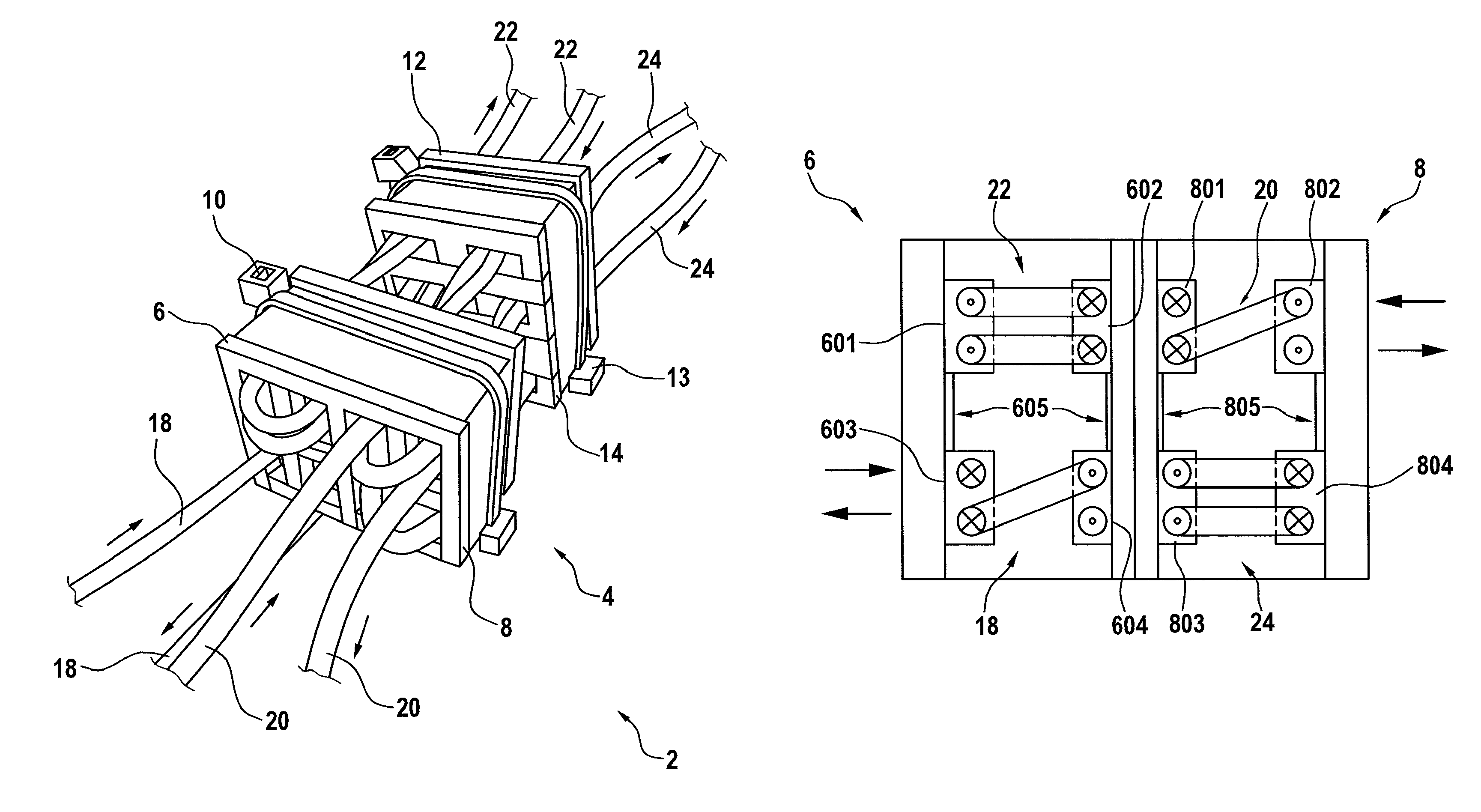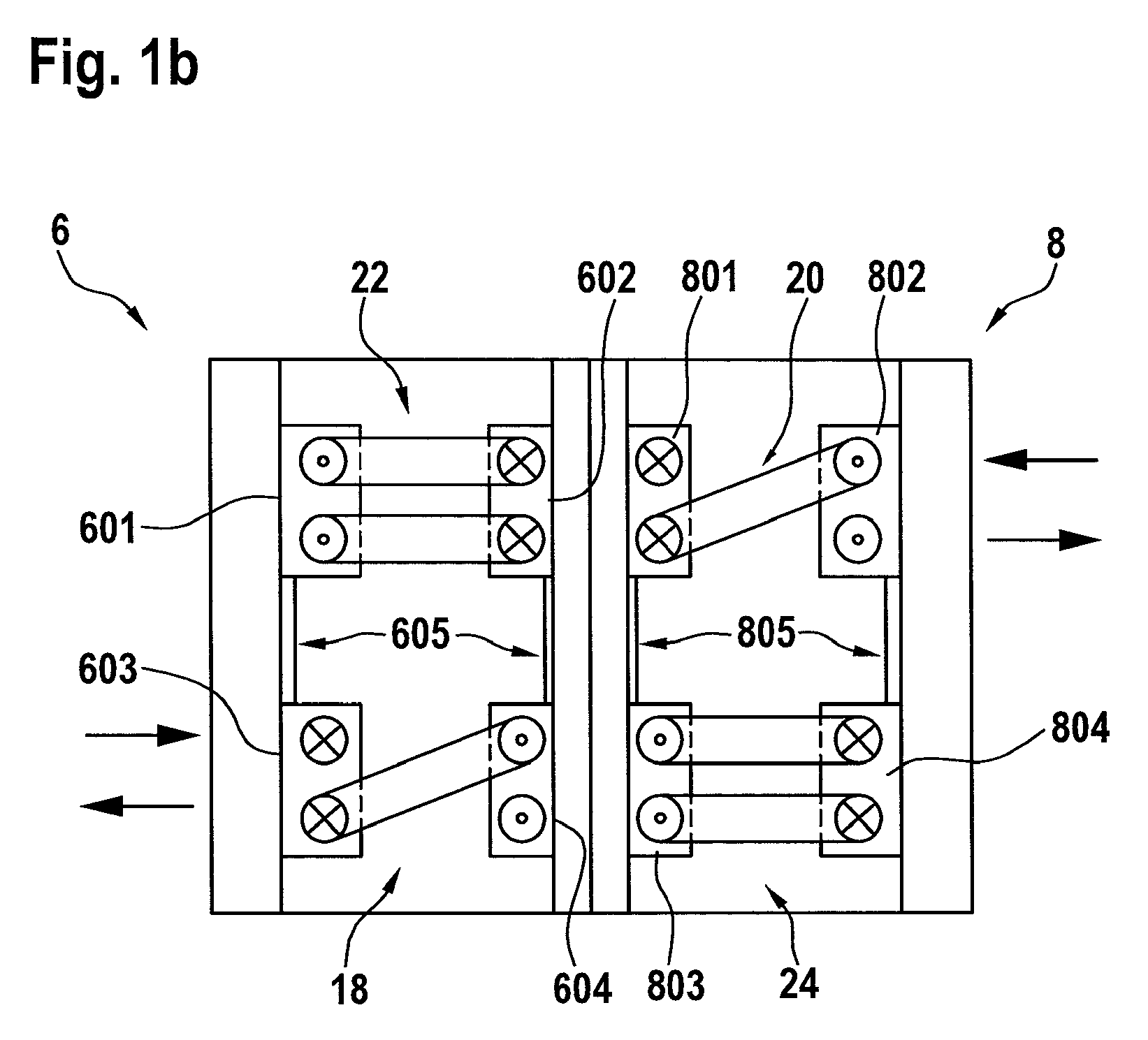Coupling device for a multi-phase converter
a multi-phase converter and coupling device technology, applied in the direction of electric variable regulation, process and machine control, instruments, etc., can solve problems such as affecting the operation of multi-phase converters, and achieve the effects of reducing the magnetic modulation of the coupling module, small core loss, and large coupling module loss
- Summary
- Abstract
- Description
- Claims
- Application Information
AI Technical Summary
Benefits of technology
Problems solved by technology
Method used
Image
Examples
first embodiment
[0023]the multi-phase converter, which is designed here as a four-phase converter and is schematically depicted in FIG. 1, comprises a coupling device 4 for four phases which have electrical voltages. The voltage of a phase and a current which flows through the phase can vary for a phase. Thus, the voltage of a phase can be a DC voltage with a superimposed AC component which can be a few percent of a value of the DC voltage. The voltage of a phase can be embodied as a clocked DC voltage.
[0024]The coupling device 4 thereby comprises a first and a second coupling module 6, 8 which can be magnetically decoupled from one another and consequently do not have to be magnetically coupled to one another. In addition, the coupling device 4 comprises a third and a fourth coupling module 12, 14 which likewise can be magnetically decoupled from one another and consequently do not have to be magnetically connected to one another.
[0025]In addition, FIG. 1 shows two bands 10, 13 by means of which c...
second embodiment
[0111]The four coupling modules 64, 66, 68, 70 are constructed and therefore designed similarly to those coupling modules 34, 36, 38, 40 of the coupling device 30 which were already presented with the aid of FIG. 2. In this regard, each coupling module 64, 66, 68, 70, as viewed from the front, has a first through-hole 6401, 6601, 6801, 7001 at the top left, a second through-hole 6402, 6602, 6802, 7002 at the top right, a third through-hole 6403, 6603, 6803, 7003 at the lower left and a fourth through-hole 6404, 6604, 6804, 7004 at the lower right. In the first coupling module 64, the first and the second through-hole 6401, 6402 are thereby connected to one another via a first slot 6405 as well as the third and the fourth through-hole 6403, 6404 via a second slot 6406. The same applies to the second coupling module 66 in which the first and the second through-hole 6601, 6602 are connected to one another via a first slot 6605 as well the third and the fourth through-hole 6603, 6604 vi...
third embodiment
[0151]In the third embodiment, each conductor loop 72, 74, 76, 78 is in each case guided once through a coupling module 64, 66, 68, 70 and therefore through a plane.
[0152]At least in the first, third and fourth embodiment, structures comprising one, two or multiple feed-throughs of a conductor loop 18, 20, 22, 24, 72, 74, 76, 78, 118, 120 through a coupling module 18, 20, 22, 24, 72, 74, 76, 78, 90 are conceivable, wherein the number of feed-throughs is typically in the small single digit range. In regard to the coupling module 90 from FIG. 4, which is designed for the fourth embodiment of the coupling device, each conductor loop 118, 120 penetrates two through-holes 110, 112, 114, 116, wherein respectively one conductor loop 118, 120 penetrates a first through-hole 110, 112, 114, 116 in a first direction and a further second through-hole 110, 112, 114, 116 in a second, opposite direction.
[0153]In the first embodiment of the coupling device 4, sections of conductor loops 18, 20, 22,...
PUM
| Property | Measurement | Unit |
|---|---|---|
| inductances | aaaaa | aaaaa |
| inductances | aaaaa | aaaaa |
| inductance | aaaaa | aaaaa |
Abstract
Description
Claims
Application Information
 Login to View More
Login to View More - R&D
- Intellectual Property
- Life Sciences
- Materials
- Tech Scout
- Unparalleled Data Quality
- Higher Quality Content
- 60% Fewer Hallucinations
Browse by: Latest US Patents, China's latest patents, Technical Efficacy Thesaurus, Application Domain, Technology Topic, Popular Technical Reports.
© 2025 PatSnap. All rights reserved.Legal|Privacy policy|Modern Slavery Act Transparency Statement|Sitemap|About US| Contact US: help@patsnap.com



